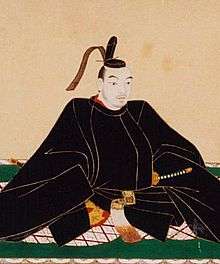Ikeda Tsugumasa
| Ikeda Tsugumasa | |
|---|---|
| 池田継政 | |
 Portrait from the Hayashibara Museum of Art | |
| Daimyō | |
| Preceded by | Ikeda Tsunamasa |
| Succeeded by | Ikeda Munemasa |
| Personal details | |
| Born | 1702 |
| Died | 1776 |
Ikeda Tsugumasa (1702–1776) (池田継政) was a daimyō of Okayama during the Edo period of Japan, and head of the Ikeda clan.[1][2] He was the father of Ikeda Munemasa, who would become daimyō following his father's retirement in 1752.[1] His father was Ikeda Tsunamasa, and Tsuguasa made additions to the Kōraku-en gardens that his father built in Okayama.[3]
He was in contact with the Rinzai monk Hakuin Ekaku, whom he first heard lecture on the Diamond Sūtra in Okayama in 1751.[4] Hakuin wrote the kana hōgo Yabukôji for the Lord,[5] and Hebi ichigo (辺鄙以知吾).[6]
References
- 1 2 Yampolsky, Philip B. (1971). The Zen Master Hakuin: Selected Writings. Columbia University Press. p. 159. ISBN 9780231060417.
The Lord of Okayama Castle is Ikeda Tsugumasa (1702-1776). He retired in the twelfth month of 1752.
- ↑ Yoshizawa, Katsushiro (2009). The Religious Art of Zen Master Hakuin. Translated by Waddell, Norman. Counterpoint LLC. p. 51. ISBN 9781458758835.
Although the Daimyo's name is deleted from the printed edition of the book, we know from the surviving manuscript that he was Lord Ikeda Tsugumasa (1702-1776), the Daimyo of Okayama.
- ↑ "Garden's scenic spots : Korakuen - One of the Three Great Gardens of Japan". Okayama Korakuen. Archived from the original on January 6, 2017.
Yuishinzan Hill was built when Ikeda Tsugumasa took over from his father Ikeda Tsunamasa. It changed the flat landscape of the garden, giving it a more sculptured aspect. Yuishin-do is located on one side of the hill, and plants such as azaleas and rhododendrons are planted there to match the rock work on the slopes. Their seasonal red and white flowers adorn the area.
- ↑ Tanahashi, Kazuaki (1984). Penetrating Laughter: Hakuin's Zen & Art. The Overlook Press. p. 19. ISBN 9780879519520.
"Spearflowers" was originally a letter to Tsugumasa Ikeda, Lord of Okayama, Bizen Provence. Ikeda first heard Hakuin lecture on a twelfth-century Chinese commentary on the Diamond Sūtra in Okayama in 1751
- ↑ Baroni, Helen Josephine (2002). "Yabukôji". The Illustrated Encyclopedia of Zen Buddhism. Rosen Publishing Group. p. 376. ISBN 9780823922406.
A kana hōgo written by Hakuin Ekaku (1685-1768) for Ikeda Tsugumasa (1702-1776), the daimyō, or lord of Okayama in 1753.
- ↑ Yoshizawa, Katsuhiro (December 19, 2003). "Hebi ichigo". International Research Institute for Zen Buddhism. Archived from the original on January 6, 2017.
This work is written in the form of a letter to Ikeda Tsugumasa, daimyō of the Okayama domain.
This article is issued from
Wikipedia.
The text is licensed under Creative Commons - Attribution - Sharealike.
Additional terms may apply for the media files.